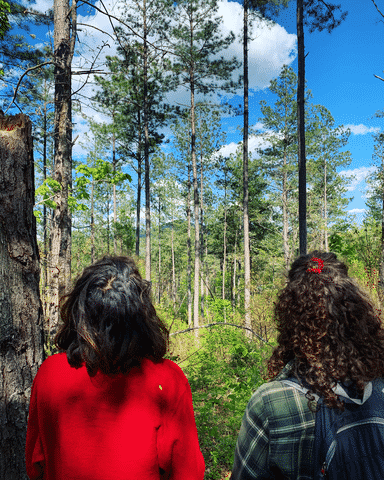Now that you know the basics about mindfulness, let’s dive in a little bit more…
The benefits of mindfulness
So why practice mindfulness? As we take time to be present to our experiences, and practice focusing on the present, we actually rewire our brains by creating new neural networks. What are neural networks, you ask? When we learn behavior (how to swim, how to write the alphabet, how to drive a car) we create a neural network in the brain–neural networks, essentially, are neurons collecting signals from others and this creates electric activity that creates connective branches in the brain. The more we repeat this behavior, the stronger the neural network becomes, and we establish this network as an “expert”—meaning that it is fully learned behavior (we don’t have to relearn it). Students hiking through the wilderness is a beautiful metaphor for this process. Imagine a single-track trail in the woods. The more this single-track is used, the more established it becomes. If we imagine how our road system started, many thoroughfares were once dirt roads, and the more certain roads were traveled, those became paved roads, and perhaps eventually highways. The brain works similarly in that behaviors we practice over and over again create a neural network of “superhighways” in the brain. This is why we can have difficulty learning new behavior as we get older, because we are working against very established neural networks.
In adolescence and young adulthood, when the brain is still developing (the frontal lobe doesn’t fully form until around age 25), practicing mindfulness can be an incredibly powerful way to impact brain development, particularly the prefrontal cortex. As we practice mindfulness, our amygdala shrinks (the fight or flight response center) and the prefrontal cortex (associated with higher order brain function such as awareness, concentration and decision making) becomes thicker. So when we practice, we are actually changing the structure of our brain! Lots of activities can boost the size of various parts of the prefrontal cortex, but it’s the disconnection of our mind from its stress center (the amygdala) that seems to give rise to a range of physical as well as mental health benefits. In a study simply on the practice of mindful breathing, participants showed reduce stress, reduction in symptoms of anxiety, insomnia, PTSD, depression and ADD. Participants also showed reduced impulsivity, increased ability to delay gratification, increased alertness, and experienced a boost to their immune systems.
In addition to the effect on the prefrontal cortex, mindfulness practices also stimulate the vagus nerve. The vagus nerve is the longest nerve in the body – starting in the brain, passing through the neck down to the abdomen. It is involved in the parasympathetic control of the heart, lungs, and digestive tract. When the vagus nerve is stimulated, the response is a reduction in stress and our bodies respond by changing the function of the part of our brains that lower blood pressure and heart rate, as well as aids in digestion. In another study, participants were given and MRI before and after a 3 day intensive mindfulness retreat and compared to other participants who experienced a 3 day intensive relaxation retreat, those who were on the mindfulness retreat showed this conclusion: “brain scans from this study showed that mindfulness meditation training increased the functional connectivity of the participants’ resting default mode network in areas directly linked to attention and executive control.” This means an increase in stress resilience and improved executive control which can improve a variety of stress-related health outcomes.
Mindfulness at Blue Ridge Therapeutic Wilderness
Blue Ridge’s Clinical Team is a strong proponent of mindfulness practices and all of therapists encourage students to incorporate mindfulness practices into their daily and weekly routines. Across all groups, students are being taught and encouraged to use:
Mindful breathing exercises
Body scans (stay tuned for more info on this one)
Using the 5 senses to become more aware of themselves in the context of their environment
Sitting with uncomfortable emotions
Mindful thought awareness practices
Mindful emotion awareness practices
Guided meditations and guided imagery
Sitting with positive affirmations from each other (a very uncomfortable practice for some of our students!)
These practices are individualized depending on the developmental and therapeutic needs of students and the group dynamic. Some of these are therapeutic assignments given individually to students by the therapist, as well as some are practiced in the group context together (for example, my team participates in a mindful body exercise every morning after which they check in with each other about what they experienced). In addition, parents involved in our family programming are encouraged to practice the mindful concepts of awareness, presence and non-judgment by identifying their feelings that arise when hearing about their child’s wilderness experience and holding this without judgment, while mindfully breathing.
How can I practice mindfulness at home?
Mindful body practices are the easiest way to incorporate mindfulness into anyone’s daily life, and primarily what we teach students in the field when they are first learning.
You can begin with a simple body scan; starting at the top of your head or the tip of your toes and use your mind’s eye to rest momentarily on each part of your body—and notice (in a non-judgmental way) any sensations you might be experiencing.
You can also practice mindful breathing; start with 3 breathing rotations and simply pay attention to your inhales and exhales, perhaps thinking “inhale” as you breathe in, and “exhale” as you breathe out. Even doing this exercise, you may notice you become distracted from your breathing. At the moment you realize this, simply notice that you are distracted (that is mindfulness!) and try to bring your attention back to your breath.
Start with one of these practices, for a few minutes each day, and gradually increase the length of your practice as you become more comfortable with it. Take note of what you are experiencing so that you can be more mindful about your thoughts, feelings, sensations and experiences throughout the day.
There are several apps that you can download and be guided through a mindfulness practice. “Headspace” is one of my personal favorites. If you have a smartphone, and you prefer to start out with guided mindfulness practices, you have a lot of resources at your fingertips.
With more familiarity about what mindfulness is and what the benefits are, I imagine you understand why we feel it is crucial for our students at Blue Ridge to use this practically and perhaps you even feel encouraged to try it at home.
References:
Mindfulness Can Literally Change Your Brain. Congleton, Hölzel, and Lazar. January 08, 2015. Harvard Business Review.
Mindfulness Meditation and the Vagus Nerve Share Many Powers. Bergland. February 5, 2016. Psychology Today.

